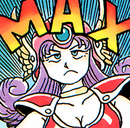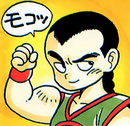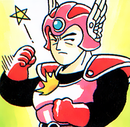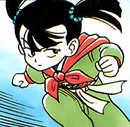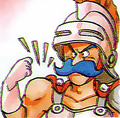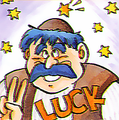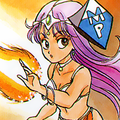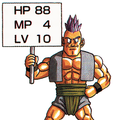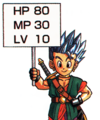List of character statistics
The following is a list of measurable statistics for playable characters which may be found throughout the Dragon Quest series. Other than normal level progression, there are seeds that can enhance a character's capabilities.
Hit Points[edit]
Hit Points (HP) determine how much health a character has remaining. All damage subtracts from this score, and if it reaches 0, the character can no longer participate in battle, and must be revived. HP can be restored via medicinal herbs, healing spells, resting at an inn, etc.
In all versions of Dragon Quest III (except Dragon Quest III HD-2D Remake) and IV, Resilience directly determines your character's maximum Hit Points. The more a character's Resilience score increases upon leveling, the more Hit Points a character will receive upon the next level increase. In all other titles, the maximum HP a character has is generally determined by their level and, if applicable, vocation. Martial Artists, Warriors, and Paladins have the highest HP on average.
Any character can consume a seed of life to increase their maximum HP.
Magic Points[edit]
Magic Points (MP) determine how much mana a character can expend to cast spells. Each spell deducts from this pool at a set rate, and cannot be cast if MP is too low. Some very special spells like Magic Burst will consume all remaining MP when cast. Starting with Dragon Quest VI, skills were introduced that also consumed MP.
In all versions of III, and IV, Wisdom directly determines your character's maximum Magic Points, paralleling the Resilience stat. In all other titles the maximum MP a character has is determined by their level and, if applicable, vocation. Prior to Dragon Quest VI, non-magical characters had no MP pools as they had no use for them, but with the addition of skills, most characters began accumulating an MP pool even if they never learned actual spells.
Any character can consume a seed of magic to increase their maximum MP.
Strength[edit]
Strength (ちから) measures how physically strong a character is, and is added to a character's weapon bonus in determining damage inflicted upon an enemy. In later installments, some skills depend on Strength for determining damage output, ignoring if a weapon is equipped.
Any character can consume a seed of strength to increase this attribute.
Resilience[edit]
Resilience (みのまもり) measures how durable a character is. Resilience is added to a character's equipment defence value to determine how much physical damage they endure when struck.
Any character can consume a seed of resilience to increase this attribute.
Dragon Quest III: The Seeds of Salvation[edit]
In all versions of III except Dragon Quest III HD-2D Remake, Resilience determines a character's potential Hit Points. The maximum Hit Points at any time is between 195~205% of the character's Resilience score. (In Dragon Quest III HD-2D Remake, this specific function is instead served by the Stamina attribute.)
Dragon Quest IV: Chapters of the Chosen[edit]
In the NES version of the game, Resilience acts as it does in III. As of the PSX port, the stat has been modified to influence defence directly.
Agility[edit]
Agility (すばやさ) determines a character's priority in turns, utilizing a Gaussian Curve with simple calculations.
In the NES versions of the first four games, as well as all versions of Dragon Quest III except Dragon Quest III HD-2D Remake, agility also contributes to the character's innate defence. If a character has no armour or other defensive gear equipped in these titles, then their defence will be half (50%) of their agility.
Any character can consume a seed of agility to increase this attribute.
Dragon Quest[edit]
Turn order is strictly dependent on the enemy in the NES version, with a 100%, 50%, 37.5%, and 25% chance for them to strike first.
Dragon Quest II: Luminaries of the Legendary Line[edit]
(Agility/2) + N, with N being 0~255. NES version only.
Dragon Quest III: The Seeds of Salvation[edit]
(Agility + 20) * (N/256), with N being a random number between 0~255.
Dragon Quest III HD-2D Remake[edit]
Turn order is calculated as ((Agility stat + buffs) + 20) * (N/100), with N being 50~100.
Dragon Quest IV: Chapters of the Chosen[edit]
Currently unknown.
Dragon Quest V: Hand of the Heavenly Bride[edit]
SNES version is calculated as Agility * (75 + N * 26/256)/100, with N being 0~255.
Dragon Quest VI: Realms of Revelation[edit]
All versions are calculated as (Agility + 20) * (N/100), with N being 50~100.
Dragon Quest VII: Fragments of the Forgotten Past[edit]
The original and remake use the same algorithm as found in VI.
Dragon Quest VIII: Journey of the Cursed King[edit]
Turn order calculation is slightly tweaked, with enemy agility directly involved in the algorithm instead of just being measured against. The chance for a character to act is (ally Agility)/(enemy Agility) * 50, with the result being converted to a percentage.
Dragon Quest IX: Sentinels of the Starry Skies[edit]
Turn order is calculated the same way as in VIII.
Dragon Quest X[edit]
The tenth game operates in real time, so players can act as quickly as they can input commands. Agility reduces the interval between actions, which is the period of time between when an action is executed and when the command window appears again to input another command.
Dragon Quest XI: Echoes of an Elusive Age[edit]
Currently unknown.
Stamina[edit]
Dragon Quest III HD-2D Remake[edit]
Stamina (たいりょく) determines a character's HP growth, identical to the Resilience stat seen in all prior versions of III.
Wisdom[edit]
Wisdom (かしこさ) measures a character's natural cognitive ability.
Any character can consume a Seed of wisdom to increase this attribute.
Dragon Quest III: The Seeds of Salvation[edit]
In III Wisdom determines a character's potential Magic Points, with the maximum at any time being 195~205% of the Wisdom stat. Additionally, the stat determined how quickly a character could learn a new spell: learning a spell could be delayed or expedited by up to five levels. This aspect was reduced in subsequent versions of the game, with the influence being three levels at most.
Dragon Quest III HD-2D Remake[edit]
Wisdom affects a character's MP growth in the same way as past iterations of the game and controls how quickly a character learns a spell, with the process now extending to skills as well; this can make certain lunkhead personalities unoptimal for melee-focused vocations as it delays the learning of crucial abilities.
Wisdom now increases magic damage by up to 60% for every spell as of the August 30th, 2025 update patch. This is done by comparing the character's current wisdom to a hidden benchmark table that is shared by all vocations; every point of wisdom that is higher than the benchmark for that level increase the power of an attack spell by 1 point until it hits the damage limit of +60%.
| Lv | *0 | *1 | *2 | *3 | *4 | *5 | *6 | *7 | *8 | *9 |
|---|---|---|---|---|---|---|---|---|---|---|
| 0 | - | 9 | 10 | 11 | 12 | 13 | 14 | 15 | 17 | 19 |
| 1 | 22 | 25 | 29 | 32 | 35 | 39 | 43 | 46 | 50 | 54 |
| 2 | 57 | 61 | 65 | 70 | 74 | 79 | 83 | 88 | 94 | 99 |
| 3 | 105 | 110 | 116 | 121 | 127 | 132 | 138 | 144 | 150 | 155 |
| 4 | 160 | 164 | 169 | 174 | 178 | 182 | 187 | 191 | 195 | 200 |
| 5 | 204 | 208 | 211 | 215 | 219 | 222 | 225 | 229 | 232 | 235 |
| 6 | 238 | 240 | 243 | 246 | 249 | 251 | 254 | 257 | 260 | 262 |
| 7 | 265 | 268 | 271 | 273 | 275 | 278 | 280 | 282 | 285 | 287 |
| 8 | 289 | 292 | 294 | 296 | 298 | 300 | 302 | 304 | 306 | 308 |
| 9 | 310 | 312 | 314 | 316 | 318 | 320 | 322 | 324 | 326 | 328 |
Dragon Quest IV: Chapters of the Chosen[edit]
Wisdom functions as it did in the previous game.
Dragon Quest V: Hand of the Heavenly Bride[edit]
A Wisdom stat of twenty is required for tamable monsters to listen to the orders of the player, disregarding instructions until the mark has been reached. It is speculated among fans that the stat also influences the A.I. efficiency of human and monster characters, but this is currently unconfirmed.
Dragon Quest VI: Realms of Revelation[edit]
Wisdom decides how intelligently an A.I. controlled character will act in battle and how they react to player actions. This lucidity stacks on top of the behavioral patterns set by the various battle commands such as Watch My Back and Show No Mercy, and as such even melee characters benefit from being bright.
| Wisdom | Behavior |
|---|---|
| 1~10 | Attacks are unfocused and random. |
| 21~30 | Effects of weapons are taken into consideration. Focus is on weaker enemies, starting from left to right. |
| 31~40 | Focus is on the weakest enemy period, ignoring previous left to right sorting method. |
| 41~60 | Damaged enemies within a group will generally be ignored if an enemy outside the group can be defeated in a single move. |
| 61~70 | Characters will always focus on the healthiest enemy in a group. |
| 71~100 | Characters begin to target the most dangerous enemy in an encounter, rather than the weakest. |
| 101~200 | Characters begin to take player action into account, altering their strategy 1/8th of the time. This acknowledgement overrides normal A.I. decision making, even if the player's action is the least intelligent choice for that turn (I.E. if the player casts Oomph on the weakling magus, the magus will attack instead of casting a powerful spell). |
| 201~300 | Player recognition raised to 1/4th. |
| 301~500 | Player recognition risen to 1/3rd. |
In games where Wisdom is not present, the character's level controls their A.I. efficiency.
Dragon Quest VIII: Journey of the Cursed King[edit]
Starting with VIII, Wisdom has also begun to effect the potency and power of spells, such as raising Frizz's power from 10~13 to 21~24 at higher values. Each spell has its own growth rate, with some taking up to five points of wisdom to increase in damage, and others as few as two.
Luck[edit]
Luck dictates the frequency that a character can avoid debuffs and status ailments cast by monsters.
Any character can consume a seed of luck to increase this attribute.
Dragon Quest III: The Seeds of Salvation[edit]
In all versions of III, Luck affects your character's chances of being affected by status ailments such as Snooze, Fizzle, and Dazzle. Each enemy spell has a different base accuracy that is lowered as the stat rises, being calculated as Probability(P) = (384 - LUCK) * MOD / 65536.
| MOD | Staus ailments |
|---|---|
| 160 | Dazzle, Deceleratle |
| 128 | Sap, Kasap, Kamikazee (locked) |
| 96 | Snooze, Fizzle |
| 64 | Fuddle |
| 32 | Whack, Thwack |
Dragon Quest III HD-2D Remake[edit]
The Luck stat's calculation for evading status ailments has been changed to ( ( 1 + ( Luck stat - hidden benchmark ) / hidden benchmark ) X 100 ) / 100. Once the adjusted Luck stat value is determined it is measured against the hidden benchmark. If it is 80% or less of the hidden benchmark then the adjusted value is multiplied by 0.8, and if it is 120% or higher then the adjusted value is multiplied by 1.2.For example, if a Hero at level 90 has 800 Luck then the calculation is ( ( 1+ ( 800 - 310) / 310 ) X 100 ) / 100, resulting in 2.58. Because the Luck stat was greater than 120% of the hidden benchmark for level 90, the 2.58 is multiplied by 1.2 for 3.096 which is then multiplied by 10 for the percentage value to be multiplied against the enemy's spell. Using Snooze as an example, the natural accuracy of 60% becomes 18.576%.
Luck also penetrates a monster's resistance to status ailments, calculated as base resistance - (0.25 X Luck / 1,000) = new resistance. For example, the Snooze spell has an accuracy of 60% and the target monster has a 25% resistance to being knocked out, lowering the accuracy to 45%. If the person casting the spell has max Luck, the calculation becomes 0.25 - (0.25 X 999 / 1,000) = 0.00025%, resulting in Snooze now having a success chance of 59.975%.
Luck also determines a character's chance to land a critical hit, with luck being divided by the hidden benchmark and then multiplied by the vocation's innate crit rate. For example, the critical hit chance for a Gadabout with 999 Luck at level 90 is calculated as 6 X (999 / 310), resulting in a chance of 19.33%.
Finally, Luck also influences the physical damage dealt by the attack command. Physical damage is lowered to 90% if the attacker's Luck stat is at least 10% less than the hidden benchmark, and is raised to 110% if the attacker's Luck stat is at least 10% greater than the hidden benchmark.
| Lv | *0 | *1 | *2 | *3 | *4 | *5 | *6 | *7 | *8 | *9 |
|---|---|---|---|---|---|---|---|---|---|---|
| 0 | - | 9 | 10 | 11 | 12 | 13 | 14 | 15 | 17 | 19 |
| 1 | 22 | 25 | 29 | 32 | 35 | 39 | 43 | 46 | 50 | 54 |
| 2 | 57 | 61 | 65 | 70 | 74 | 79 | 83 | 88 | 94 | 99 |
| 3 | 105 | 110 | 116 | 121 | 127 | 132 | 138 | 144 | 150 | 155 |
| 4 | 160 | 164 | 169 | 174 | 178 | 182 | 187 | 191 | 195 | 200 |
| 5 | 204 | 208 | 211 | 215 | 219 | 222 | 225 | 229 | 232 | 235 |
| 6 | 238 | 240 | 243 | 246 | 249 | 251 | 254 | 257 | 260 | 262 |
| 7 | 265 | 268 | 271 | 273 | 275 | 278 | 280 | 282 | 285 | 287 |
| 8 | 289 | 292 | 294 | 296 | 298 | 300 | 302 | 304 | 306 | 308 |
| 9 | 310 | 312 | 314 | 316 | 318 | 320 | 322 | 324 | 326 | 328 |
| Vocation | Crit Value | Level Range |
|---|---|---|
| Gadabout | 3 | 1–9 |
| 4 | 10–20 | |
| 5 | 21–30 | |
| 6 | 31–99 | |
| Hero | 2 | 1–5 |
| 2.5 | 6–10 | |
| 3 | 11–15 | |
| 3.5 | 16–20 | |
| 4 | 21–25 | |
| 4.5 | 26–30 | |
| 5 | 31–35 | |
| 5.5 | 36–40 | |
| 6 | 41–45 | |
| 6.5 | 46–50 | |
| 7 | 51–55 | |
| 7.5 | 56–60 | |
| 8 | 61–65 | |
| 8.5 | 66–70 | |
| 9 | 71–75 | |
| 9.5 | 76–90 | |
| 10 | 81–99 | |
| Mage | 3 | 1–99 |
| Martial Artist | 4 | 1–4 |
| 5 | 5–9 | |
| 6 | 10–14 | |
| 7 | 15–20 | |
| 8 | 21–25 | |
| 9 | 26–30 | |
| 10 | 31–35 | |
| 11 | 36–40 | |
| 12 | 41–45 | |
| 13 | 46–50 | |
| 14 | 51–55 | |
| 15 | 56–60 | |
| 16 | 61–65 | |
| 17 | 66–70 | |
| 18 | 71–75 | |
| 19 | 76–80 | |
| 20 | 81–99 | |
| Merchant | 2 | 1–99 |
| Monster Wrangler | 3 | 1–99 |
| Priest | 2 | 1–99 |
| Sage | 2 | 1–99 |
| Thief | 2 | 1–99 |
| Warrior | 2 | 1–99 |
Dragon Quest IV: Chapters of the Chosen[edit]
Luck functions as it had in III.
Dragon Quest V: Hand of the Heavenly Bride[edit]
In V, Luck determines the accuracy of an enemy curse rather than status ailment spells, with fixed accuracy rates assigned to enemy spells.
Style[edit]
Style (かっこよさ) is the predecessor of the Charm attribute to be found in later games, and as such it describes a character's innate charisma and attractiveness. Any character can increase their style by consuming a Pretty betsy.
Dragon Quest VI: Realms of Revelation[edit]
Style determines a character's placement in the contests such as the World Style Ranking in Château de Sass.
A common misconception is that style influences the Luminary vocation's ability to stun monsters. This is false, as the stun chance is based on the character's ranking in the vocation rather than any stat.
Dragon Quest VII: Fragments of the Forgotten Past[edit]
Style operates as it had in VI, and is required to one a section of the the Excellence Grading Organisation competition.
Deftness[edit]
Deftness (きようさ) measures the ability of a character to steal an item from an enemy, as well as controlling how frequently a character may perform a critical hit, conduct preemptive strikes on enemies, and escape from battle.
Dragon Quest IX: Sentinels of the Starry Skies[edit]
The critical hit rate is calculated as Deftness/100 + 3% (with weapon skill trait boost). Wearing the Critical Acclaim will add another 4%, and thus the maximum rate is 16.99% at 999 deftness.
Dragon Quest X[edit]
Currently unknown.
Dragon Quest XI: Echoes of an Elusive Age[edit]
Erik's steal rate is calculated as Deftness/20, meaning that every 20 points will increase his chance for success by 1%. With his guile bonuses this brings the maximum rate to 75%.
Similarly, the critical hit rate is calculated as Deftness/200, which limits the natural cap to 5%.
Any character can consume a seed of deftness to increase this attribute.
Charm[edit]
Charm (みりょく) is a measurement of a character's attractiveness. Introduced in Dragon Quest IX, it is added to a character's equipment style rating in determining how often they may enthrall a monster. Enraptured foes have a 90% chance to be stunned for 1~2 turns, a 5% chance to become Paralysed for 1~4 turns, and a 5% chance to become Confused for 6~9 turns.
Dragon Quest IX: Sentinels of the Starry Skies[edit]
The chance to stun a monster is calculated as (Current charm - innate charm + equipment bonus - 100) * 0.02, which is then multiplied against a monster's charm resistance. Current charm is the programming check to see if Extreme Makeover has been applied or not, and the equipment bonus is the sum of the style of a character's gear plus their innate charm and this total is added again to the innate charm during the calculation check.
Dragon Quest X[edit]
Currently unknown.
Dragon Quest XI: Echoes of an Elusive Age[edit]
A character's total is simply calculated by their innate charm plus any charm granted by their equipment. It cannot be reduced by wearing any piece of equipment, but there are many pieces that grant extra charm. It also affects certain skills used by both Sylvando and Jade, such as the amount recovered by Hustle Dance or the damage inflicted by That's Amore and Sexy Beam. Monsters can still become stunned for a single turn particularly if a character's Charm is high enough, but it is a much rarer occurrence in this game and some monsters are completely immune to the effects in any case.
Any character that consumes some pretty betsy will increase this attribute.
Magical Mending[edit]
Magical Mending (かいふく魔力) determines how powerful a character's healing spells will be. Introduced in Dragon Quest IX, it is calculated in all healing spells, as well as certain offensive skills and spells such as Solar Flair and the Whack line.
Any character can consume a seed of therapeusis to increase this attribute.
Magical Might[edit]
Magical Might (こうげき魔力) determines how powerful a character's attack spells will be. Introduced in Dragon Quest IX, it is calculated in all offensive magical spells, as well as select skills such as Gigaslash, and as part of the accuracy of status spells such as Fizzle.
Any character can consume a seed of sorcery to increase this attribute.
Weight[edit]
Weight is a measurement of a character or monster's heaviness. In some spinoff games, it is mostly used to place restrictions on the player's party if the sum of all members' weight exceeds a certain amount. However, in Dragon Quest X, weight affects how much a character can push an enemy in order to hinder their progress or to prevent a character from being moved by an enemy's attacks.
Dragon Quest X[edit]
A character's weight is the sum of their own weight and their equipment's weight.[1]Hammers are the heaviest one-handed weapons and spears are the heaviest two-handed weapons. Heavy armour and greatshields add the most weight to a character. Weight is one of the most important attributes for a Paladin as they can prevent certain bosses from performing attacks by being heavier than them. It can be temporarily increased with spells and abilities.
In the earliest stages of the game, a character's weight was also determined by their race, with Ogres weighing the most and Poppets weighing the least. However, starting with Version 3.2 of the game, this difference between races was removed. There is no negative side effect to a character's weight.
Dragon Quest Tact[edit]
A unit's weight is determined by their rank, with F-rank monsters weighing the least at only 5 each and S-ranks weighing the most, particularly characters of the Hero family and Demon Lords belonging to the ??? family. Typically, it is used to place restrictions on the Monster Arena in order to balance out player teams by limiting the total weight that a team can add up to. There are certain quests that will grant extra rewards if the player is able to complete the stage under certain weight limits.
Derived stats[edit]
Attack[edit]
Attack is used to determine how hard a character can hit with melee attacks. It is checked against the enemy's Defense in calculation of damage inflicted.
Attack is derived from a character's strength stat added to their weapon's attack bonus, which is then divided by two, plus further bonuses from certain accessories or vocation traits.
Defence[edit]
Defence (originally spelled as Defense in earlier Enix localizations) is the sum of a character's Resilience and Armour equipped, if any, checked against the enemy's Attack in calculations for damage. Every four points of defence reduces enemy damage by one point. It has no effect on magical or breath damage, which are dependent on spells/skills and equipment traits.
In the NES titles, as well as all versions of Dragon Quest III except Dragon Quest III HD-2D Remake, Defence is the sum of half a character's Agility and the sum of their armor's durability.
Evasion[edit]
The base chance to dodge an enemy blow in any game is always 1.5625% (1⁄64). This can be further raised through equipment and vocation bonuses if available, such as the Dark robe and Dancer.
In VI, VII, and VIII a character's agility will also determine their probability to dodge physical strikes. The game's programming checks the agility stat of the target before an attack is made, and if the stat surpasses a certain value then the programming checks to see if the blow lands:
Dragon Quest VI[edit]
If a character's agility is below 400, evasion is calculated as [(Agility/80)+3]/192 for a cap of 1/24 at 400. Once a character's agility surpasses 400, evasion is calculated as ([{(Agility-400)*6}/25]+8)/192 for a maximum dodge rate of 1/6 at 500. In other words, the evade chances are:
| Agility | Chance to evade |
|---|---|
| 1 | 1.56% |
| 50 | 1.89% |
| 100 | 2.21% |
| 200 | 2.86% |
| 300 | 3.52% |
| 400 | 4.17% |
| 401 | 4.29% |
| 425 | 7.29% |
| 450 | 10.42% |
| 475 | 13.54% |
| 500 | 16.67% |
- Factors such as vocation bonuses and the effects of spells and skill also influence dodge rates.
Dragon Quest VII: Fragments of the Forgotten Past[edit]
Dodge rates are calculated the same way as they were in VI.
Dragon Quest VIII: Journey of the Cursed King[edit]
| Agility | Chance to evade |
|---|---|
| 1~249 | 1.56% |
| 250~499 | 3.12% |
| 500~749 | 6.25% |
| 750~998 | 12.5% |
| 999 | 25% |
- Note: if a character has raised his or her Fisticuffs level to receive an increase in evasion, the default is raised to 50% before stacking with all other bonuses. The character's level must be higher than the attacking enemy's for the boost to take effect.
As can be inferred, the spell Acceleratle is vitally important when battling strong foes, even slower ones.
Dragon Quest IX: Sentinels of the Starry Skies[edit]
Evasion rates are now clearly displayed and several pieces of equipment now grant small boosts to evasion, stacking with the agility stat influence.
Dragon Quest XI: Echoes of an Elusive Age[edit]
The system has not changed from IX, though being in a pepped up state now flat out doubles Erik and Sylvando's evasion rates.
Trivia[edit]
- Wisdom's relation to A.I. was not revealed through an official square-enix channel, but the November 10th, 2000 issue of Dengeki! Playstation magazine (電撃PlayStation). The issue featured an article that was a response to reader mail asking what the purpose of the stat was, and described an experiment with Ruff and healing wounded allies--the wild child would only use Kerplunk Dance when his wisdom was at 63, even if other characters were only at half health. The article went on to state that once his wisdom broke the 100 threshold and the test began again, Ruff would use Hustle Dance instead, recognizing that the greater healing power in the former skill was too costly for a non-emergency situation.
Gallery[edit]
Ragnar McRyan (Strength)
Kiryl (Resilience)
Torneko Taloon (Luck)
Maya Mahabala (Magic Points)
References[edit]

